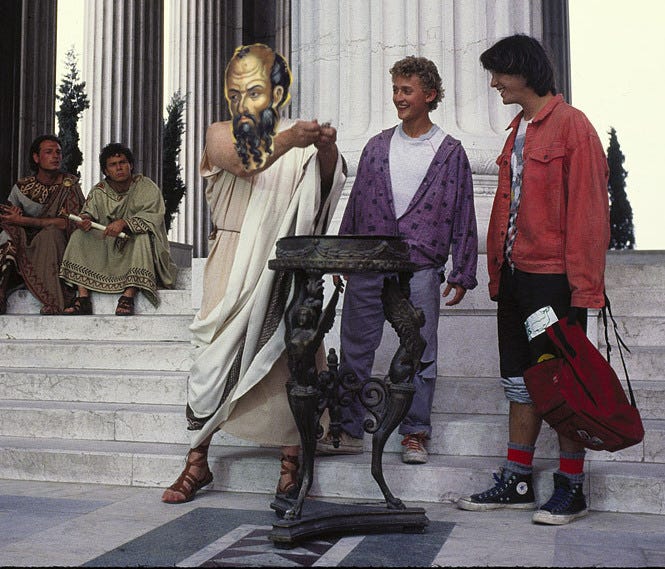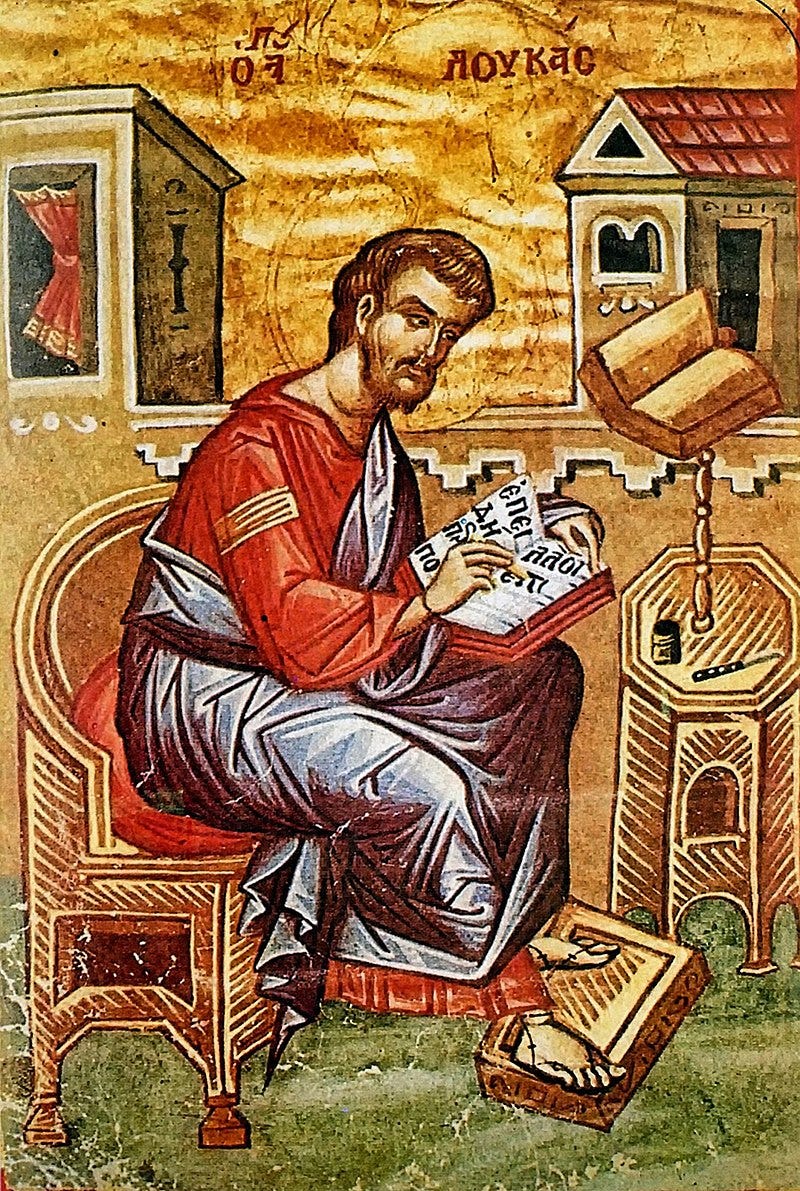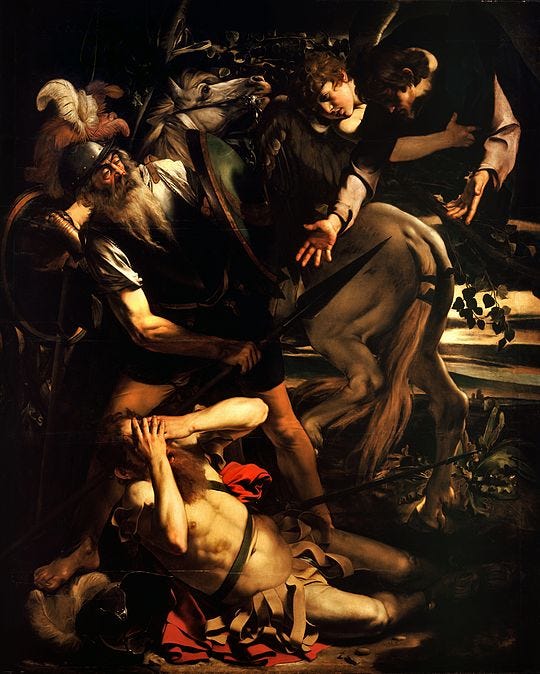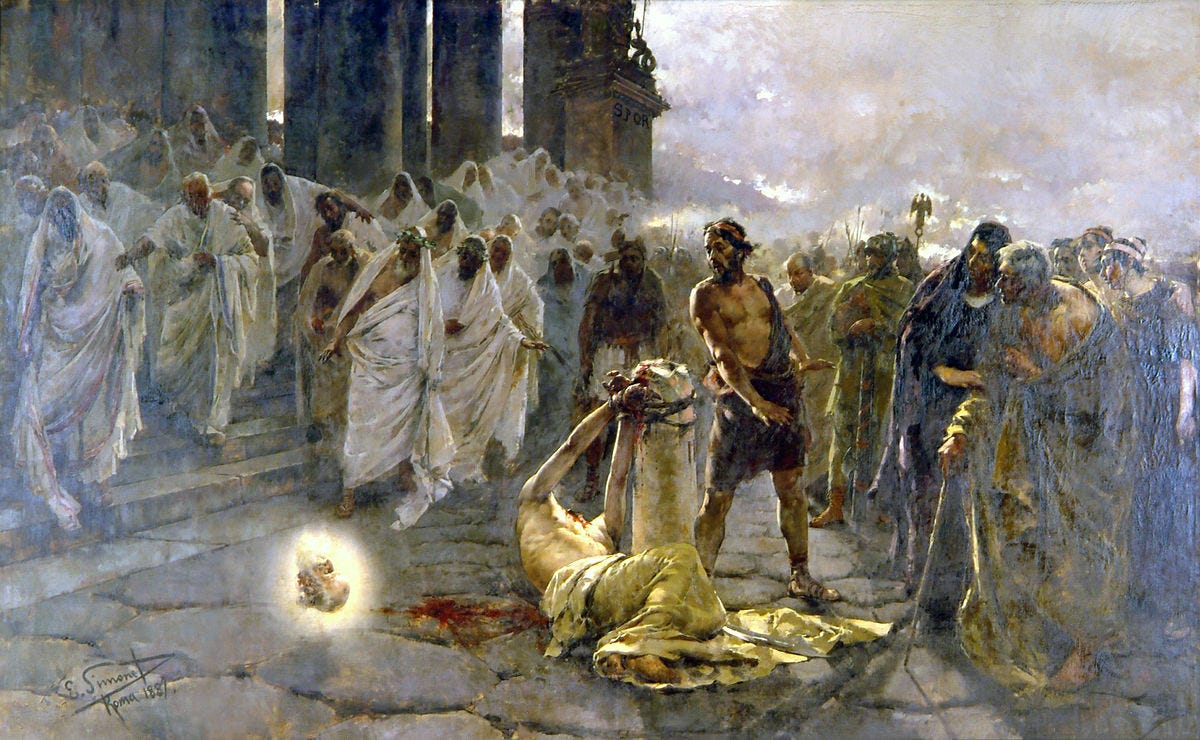Introduction to Paul the Apostle (Part I)
The Many Faces of the Most Influential Early Christian | Part 1: Introduction and the Sources on the Life and Thought of Paul
Introduction
Paul the Apostle is a complicated character to situate and understand in early Christian history because we are limited in what we know about the actual person. His family is largely a mystery; exceedingly little has been recorded of his early life; and the details of his death are more myth than history. This may be shocking to read since his letters make up a large portion of the New Testament, and he is a central figure in the Book of Acts. That said, his influence in early Christianity is substantial,—his letters were circulated, read, and revered early on (cf. 1 Clem. 47.1–3; 2 Cor 10:10)—but when you reflect on him, how much can you say with certainty? Reliable biographical information is scant: His letters are peppered with few details and the data provided by Acts is suspect.1
When I say we are limited in our knowledge, that is not to imply we are completely at a loss. If you and I were Bill & Ted, though, and we met the living, breathing Paul, our conceptualization would be vastly different from the man before us.
Moreover, what Paul thought is hard to pin down as well since we are always reading one side of a conversation.2 Everything we have from Paul’s own hand are epistles addressing specific problems and situations for particular communities; Paul is anything but systematic or consistent (e.g., his use of Isa 45:23 in Rom 14:11 and Phil 2:9–11).3 His arguments are tailored to persuade and instruct distinct groups of neophytes whose struggles and milieu were not identical (cf. 1 Cor 9:19–23), so because of this, even ancient Christians struggled to understand Paul's letters (2 Peter 3:15–16). We do not have in our possession a structured treatise on Paul’s theology,4 and what we do believe about pauline thought is invariably a construction from these multifarious correspondences.5
We have a Frankenstein’s monster when considering how the Church talks about and portrays Paul—an imperfect image amalgamated from various aspects, some of which are authentic, some legendary.
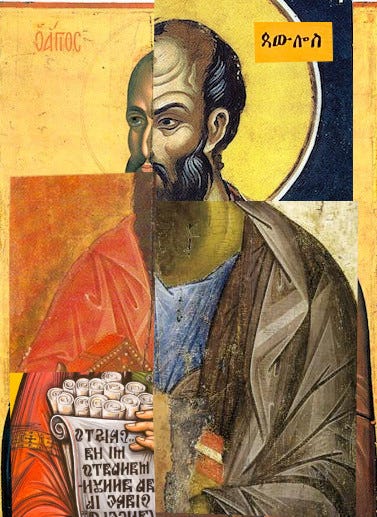
There is nothing inherently wrong with this—we do this with all historical figures6—but that does not quash the argument that this is an artifice, a distorted shadow of the actual person from history.
In this introductory series on the apostle, I will provide a source of information on what we know about who Paul was. Additionally, I will explore some ecclesial beliefs about Paul and the origin of these notions. Overall, this examination is meant to be a cursory overview of Paul the Apostle, who he was, what he wrote, and how he’s been understood.7
Biographical Sources on Paul | Establishing our Epistemology
Who was Paul the Apostle, what do we know about him, and how do we know it? This first entry will explore a critical starting point in answering these basic questions: establishing the texts that provide pertinent information. Not all sources on Paul should be weighted equally, and not all texts that discuss Paul are reliable.8 The majority of what we know about him comes from two works: the Book of Acts and the Pauline Epistles.
The Book of Acts
Tradition holds that Luke, a physician and companion of Paul,9 is the author, but there is serious doubt that this individual actually composed the Gospel and Acts. For convenience, “Luke" will serve as a stand-in, but there is no authorial claim in the dopplewerk.10 Regardless of authorship, was this individual a reliable historian?
Luke, more or less, measures up to the standards of recording history11 in antiquity, such as Herodotus (5 c. BC),12 Thucydides (5 c. BC),13 and Polybius (2 c. BC), as well as to his contemporaries, e.g., the Jewish historian Josephus.14 His methods are also lauded by the 4th c. Christian historian Eusebius,15 though his bias should be acknowledged. Provided are a number of excerpts from ancient historians that illustrate some of their basic methodologies in order to situate Luke:16
Polybius
In the same fashion systematic history too consists of three parts, the first being the industrious study of memoir and other documents and a comparison of their contents, the second the survey of cities, places, rivers, lakes, and in general all the peculiar features of land and sea and the distances of one place from another, and the third being the review of political events… (Hist. 12.25e)17
Plutarch (1–2 c. AD)
Just as geographers, O Socius Senecio, crowd on to the outer edges of their maps the parts of the earth which elude their knowledge, with explanatory notes that "What lies beyond is sandy desert without water and full of wild beasts," or "blind marsh," or "Scythian cold," or "frozen sea," so in the writing of my Parallel Lives, now that I have traversed those periods of time which are accessible to probable reasoning and which afford basis for a history dealing with facts, I might well say of the earlier periods: "What lies beyond is full of marvels and unreality, a land of poets and fabulists, of doubt and obscurity." (Theseus 1.1)
The Gospel's introduction (Luke 1:1–4) illustrates that Luke strove to be counted amongst these other chroniclers. His two-part work begins with some elements from the examples above, but there is also a clear aspiration to supply an historical account:
Inasmuch as many have undertaken to compile a narrative of the things which have been accomplished among us, just as they were delivered to us by those who from the beginning were eyewitnesses and ministers of the word, it seemed good to me also, having followed all things closely for some time past, to write an orderly account for you, most excellent The-oph′ilus, that you may know the truth concerning the things of which you have been informed.
Luke's history is anything but perfect, though; there are discrepancies in Acts when compared to Paul’s letters,18 as we will explore in future publications. Regardless of any shortcomings, Luke provided a valuable history, and we can cautiously say that there is important data for discovering the historical Paul.
Note that Luke is a Christian historian, whose purpose for writing is more than just divulging a banal history of the early Church. In part, Luke’s intent was to detail the birth of the Church, the life of early Christianity’s greatest missionary (Paul), and how the Gospel spread across the world—a theological impetus ultimately drove the author’s pen. In turn, there are certainly some exaggerations and omissions,19 and Luke took plenty of liberties. Paul’s speeches are rather formulaic, for example;20 Herod's death is truncated and quite fantastical (12:20–23); and Stephen has an elongated review of Salvation History right before he is stoned (7:1–53).21
As it is with any telling, authors tend to highlight their heroes’ strengths rather than their weaknesses, and this is the case in Acts’ depiction of Paul, post-conversion.
For instance, Paul himself references a thorn in his side (2 Cor 12:7ff.), a clear indication of some personal struggle,22 but it is imperceptible in Acts.
There are four approaches from which we can choose when reading Luke’s account:
Blind acceptance of what’s recorded in Acts
Complete denial of any historicity in Acts
A moderate approach prioritizing Paul while hesitantly supplementing our understanding from Acts
Prioritizing Acts since it is a more fleshed out, cohesive narrative, while referencing Paul's letters when fitting
The third option is most appealing since there is a hierarchy of reliability when it comes to information. A person’s first hand account, especially when it pertains to themselves, should hold more water in comparison to a third party, even if one were to believe the author of Acts was a companion of Paul for a time.23 Paul should be considered the authority, and Acts should be read through a lens of healthy skepticism.
The Pauline Epistles
Most would assume that Paul’s letters should be a cut and dried topic. The thirteen books that bear Paul’s name were all composed by the Apostle, right?
The pauline epistles are regrettably more complicated than Paul’s name is attached to the letter, therefore it was written by him. 13 epistles claim pauline authorship,24 but only 7 are uncontested, known as the Undisputed Letters of Paul.25 These include:
1 Thessalonians
Galatians
Philippians
Philemon
1 Corinthians
2 Corinthians
Romans
The remaining epistles are called the Deutero-Pauline Letters or the Disputed Letters of Paul.26 There is not a unanimous consensus if these are all pseudepigrapha,—false authorship—but the following letters are in descending order of authorial authenticity:
2 Thessalonians
Colossians
Ephesians
Titus
1 Timothy
2 Timothy
There are numerous reasons why there is speculation on the authorship of these epistles, but we will not dive deeply into this topic. Succinctly, skepticism is based on:27
Vocabulary and Style—Apparent more so in the Greek, the style of these letters do not resemble the same sentence structure and vocabulary of the undisputed letters. A good example of this is Eph 1:15–23; this is all one sentence, which is abnormally long for Paul.
Historical Setting—This pertains to uncertainty of who the recipients were. There is a textual variant in Eph 1:1. Some manuscripts (mss) claim Ephesians; others “to the saints who are also faithful in Christ Jesus”; and Marcion, an early Christian heretic, believed the letter was addressed to the Laodiceans.28 As far as we know, Paul did not write any open letters, so the second textual variant raises some suspicion—he was always addressing specific problems, to particular communities.
Theology—how certain topics are discussed in the disputed texts appear to diverge from Paul's presentation of them in the legitimate letters.29 For instance, the Deutero-Pauline epistles portray ecclesial hierarchy differently. It seems strange that Paul wrote about deacons, presbyters, and bishops in later epistles (1 Tim 3:1–13) but does not mention them in 1 Corinthians30 where there is clearly a leadership problem.31
Lack of Biographical Details—Paul makes appeals to his life and ministry when addressing these communities (e.g., 2 Cor 11:24–27; Gal 1:14–24). At times this is absent in the disputed letters; but, when there is a reference to biographical information, it feels fabricated and generic, e.g. Eph 3:1–7.32
Appeals to Authenticity—At the end of many of the pseudo-pauline epistles, there are simulated conclusions that appear to sound like Paul, such as sending someone to the community (Eph 6:21–22) or claiming legitimacy because of the large handwriting.33 Mimicry is a tactic by forgers to garner credibility—emulate the style enough to be convincing, yet sufficiently vague to conceal the subterfuge.34
Literary Dependency—This broadly applies to both the Deutero-Pauline epistles and the Catholic Epistles. The structure and themes35 of many letters appear reliant on another, which calls into question authorship. For Paul, there is a clear genetic relationship between Ephesians and Colossians.36
Forgeries were a known issue in antiquity, and these attempts did not always occur posthumously. If 2 Thessalonians is authentic,37 2:2 reveals that Paul knew of others who were fabricating letters with his name affixed to them:38
We beg you, brethren, not to be quickly shaken in mind or excited, either by spirit or by word, or by letter purporting to be from us, to the effect that the day of the Lord has come.
Additionally, there are other letters that claim pauline authorship that are known forgeries and are not canonical: the lost Letter to the Alexandrians and two others that are extant, Laodiceans and 3 Corinthians, both of which were created to fill a perceived gap in the corpus.39
Your reaction to this content may be gut-wrenching. That is perfectly fine, but consider the following.
There is no pressure to take this as gospel. You may also think, could Paul not have just changed his writing style for the letter to the Ephesians? That is entirely possible.40 But, Occam's razor would insist that this is far less likely; the explanation with the fewest assumptions is the more probable answer, especially when there are compounding indicators.
Both sides are incapable of incontrovertibly proving their position, but for most the evidence weighs in favor of a different author or Pauline “school”41 that composed these 6 letters. As such, there is still disagreement in the academy, and many still consider the evidence insufficient to speculate an imposter masquerading as Paul.
This is ultimately not a piece on Pseudepigraphy,42 canonicity, or the implications of authorship,43 so we will not explore this topic further. There are many on both sides of the argument, so no matter where one falls, you have company. As Luke Timothy Johnson notes, “To be sure, the existence of a majority opinion is far from a guarantee of the truth of that position.”44
Lastly, if you believe skepticism towards canonical books is a modern invention, it certainly is not. Eusebius writes concerning the petrine epistles,
Of Peter, one epistle, that which is called his first, is admitted, and the ancient presbyters used this in their own writings as unquestioned, but the so-called second Epistle we have not received as canonical, but nevertheless it has appeared useful to many, and has been studied with other Scriptures (Eccl. Hist. 3.3).45
He expresses doubt for pauline authorship for Hebrews—the book contains no authorial claim46—and contemplates the canonicity of The Shepherd of Hermas.47
Canon lists are inconsistent even today,48 and there was speculation even among early Christians. Martin Rist notes,
The so-called Muratorian Canon lists the books which were acceptable as scripture in the church of Rome around 200 A.D. and some that were to be rejected. The statement that I and II Timothy and Titus were to be accepted, for they “have been honored by the ordinances of the discipline of the Catholic church,” indicates that whereas there might have been some question about them, usage made them acceptable.49
As you can see, pseudepigraphy, forgeries, doubts, and skepticism are not modern debates for biblical texts.
There is a bit of a predicament for evaluating the pauline epistles. The disputed letters, if truly written by an imposter, contain little reliable data about the apostle.
At best, they reveal how the early Church understood Paul, and how some early Christians developed his thought rather than disclosing any credible information about the historical figure.
The Acts of Paul
The most unreliable source we will discuss is a non-canonical book, The Acts of Paul.50 No single manuscript of the entire work exists, but there are significant records of the text in Greek and Coptic. The book circulated as three separate parts: the Acts of Paul and Thecla, the Third Epistle to the Corinthians, and the Martyrdom of Paul. One reason for its importance is because it contains an early legend of the events leading up to Paul’s demise.51
The Acts of Paul and Thecla reads similarly to the Acts of the Apostle. The contents of the book center around Paul’s interactions with others while journeying around the Mediterranean.
That said, there is likely little reliable information that can be mined from this work for helping us construct our understanding of Paul, what he thought or did. When considering the date of the work—as late as the end of the second century—and the general nature of the piece—overly extolling—the book could largely be a fabrication. Even in the Early Church, figures doubted its authenticity, such as Tertullian (On Bapt. 17), who claimed the forger had been caught, and Eusebius (Eccl. Hist. 3.3.5).
J. K. Elliott claims,
The main motive for its composition seems to have been to set already existing legends about Paul (some possibly oral) in sequence, as an act of devotion to his memory. 52
Although there seems to be little historical value in this text, it will play a role later in the development of understanding Paul. At the very least, it illustrates early reverence towards the apostle and the desire of the nascent Church to know as much as possible about him, even if fabricated.
Conclusion
This concludes our discussion on establishing sources on Paul's life and thought. As it stands, our hierarchy of reliability follows:
Undisputed letters
Acts of the Apostles
Deutero-Pauline Epistles
Acts of Paul
Any other document on his life/thought53
Iconography and art54
Next, I plan to write about what Paul may have looked like and some general details about his life—what we know from his letters and Acts. In the comments below, let me know what you found most interesting, anything else you want to know about Paul, or any disagreements. If you wish to keep reading about Paul’s life and thought or the New Testament in general, would you kindly press the subscribe button below?
This is not to imply that Acts is a worthless, untrustworthy source. J. D. G. Dunn, 1 Corinthians (London: Continuum, 1995), 14 remarks, “...we can draw on Acts to fill in the background to 1 Corinthians with greater confidence than is often the case.” Now, he does offer suspicion for how reliable the document is, but he does not jettison the text entirely.
The interminable amount of literature that exists discussing pauline thought is evidence of this.
This will be explored in a later post on Paul’s use of Scripture.
C. K. Barrett, The Epistle to the Romans, rev. ed. (London: Continuum, 1991), 1 remarks, “That this epistle [Romans] is the apostle’s greatest piece of sustained theological writing is self-evident. That its influence upon the life and thought of the Christian Church has been radical and far-reaching needs no demonstration; it suffices to mention the names of Augustine, Luther, Wesley, and Barth.”
See D. Horrell, An Introduction to the Study of Paul, 2nd ed. (London: T&T Clark, 2006), 57. Can a coherent theology be found in the pauline epistles? Personally, no, I do not believe this is even remotely possible. Rather, we should focus on each individual letter and act as if each can speak for itself—each is a member at a table, and they can be put in conversation with one another. Since no cohesive theological document exists, that is the best we can hope to achieve, to note when Paul agrees and disagrees with himself.
For instance, Americans know the story of George Washington and the cherry tree, but this story is apocryphal, created by Mason Locke Weems. This legend has informed and influenced how many view the president, and it is a fabrication.
This series is a heavily reworked expansion of a lecture I gave in grad school at UGA, RELI1001 Introduction to Religion (Judaism, Christianity, and Islam). The outline I produced can be found here.
For instance, in the Book of the Cock (composed in Ge’ez, classical Ethiopian, 5/6 c.), the author places Paul in the betrayal of Christ: “Jesus touched the slain cock and it stood up whole. He bade it follow Judas and see what he did, and return and report it: he endowed it with human speech. It followed Judas home: his wife urged him to betray Jesus. He went to the temple. The dialogue with the Jews is reported, and Paul of Tarsus, ‘son of Josue Almason, son of Cadafanâ’, a rough man, says, ‘Now, thou, deliver him into my hands without error.’” Translation from M. James, ed., The Apocryphal New Testament (Oxford: Clarendon, 1924), 150.
Paul refers to a “Luke” in Philemon 24. The idea that this person—assuming the reference is to the same individual—is a physician comes from Col 4:14. A “Luke” is also mentioned—along with a “Demas,” cp. last reference to Colossians—in 2 Tim 4:11, but these last two letters are dubious.
A common name for the Gospel and Acts, German in origin, meaning “double work.”
How the author begins the Gospel and Acts indicates that he wanted his work to be considered a history. Space does not allow an extensive discussion, though. For a detailed overview, consult Loveday Alexander, The Preface to Luke's Gospel (New York: Cambridge, 1993) and Acts in its Ancient Literary Context (London: T&T Clark, 2005).
Herodotus shows skepticism towards his sources: “It is said that there is a lake on this island from which the maidens of the country draw gold-dust out of the mud on feathers smeared with pitch. I do not know whether this is true; I just write what is said. But all things are possible; for I myself saw pitch drawn from the water of a pool in Zacynthus” (4.195.2).
Thucydides at times discusses how he constructed his history, “Indeed, as to the events of the period just preceding this, and those of a still earlier date, it was impossible to get clear information on account of lapse of time; but from evidence which, on pushing my inquiries to the furthest point, I find that I can trust, I think think that they were not really great either as regards the wars then waged or in other particulars.” His methodology is given in more detail in 1.22.
Cf. M. Hengel, Acts and the History of Earliest Christianity (London: SCM, 1980). For a discussion on the historical value of Acts and a survey of thought on the subject, consult G. Lüdemann, Early Christianity according to the Traditions in Acts (Minneapolis: Fortress, 1984), 1–18. The statement above is not meant to imply all those historians mentioned would necessarily agree in terms of historiography. Luke aligns more with Herodotus than he would Polybius; simply, Luke finds himself in the company of other historians. He is not an aberrant chronicler doing his own thing.
He claims, “Luke was by race an Antiochian and by profession a physician. He long had been a companion of Paul and had more than a casual acquaintance with the rest of the apostles. He left for us, in two inspired books, examples of the art of healing souls that he obtained from them. These books are, namely, the Gospel… the Acts of the Apostles, which he composed not from hearsay evidence but as demonstrated before his own eyes. They say that Paul was actually accustomed to quote the Gospel according to St. Luke. When writing about some Gospel as his own, he used to say, ‘According to my Gospel [Rom 2:16; 16:25; 2 Tim 2:8]’” (Hist. eccl. 3.4).
This is not meant to be an exhaustive list to define what historiography was in antiquity. Rather, it is a sampling to provide a base for understanding how Luke related to his fellow historians.
He also writes, “A historical author should not try to thrill his readers by such exaggerated pictures, nor should he, like a tragic poet, try to imagine the probably utterances of his characters or reckon up all the consequences probably incidental to the occurrences with which he deals, but simple record what really happened and what really was said, however commonplace” (Hist. 2.56.10–12).
We are not certain what letters Luke may have had, if any. Our ignorance of his sources is also problematic for assessing the Evangelist’s reliability. That said, R. Schellenberg, “The First Pauline Chronologist?” JBL 134.1 (2015): 193–213 attempts to line up Paul's references to his travels with what is recorded in Acts.
As R. Brown, An Introduction to the New Testament (New Haven: Yale, 1997), 423 wrote, “Moreover, the author may have had only a sketchy view of parts of Paul’s career, so that he telescoped and compacted complex events.”
Though, this is not surprising considering the difficulty of recording speeches in antiquity. As Thucydides detailed in his own history, “With reference to the speeches in this history, some were delivered before the war began, others while it was going on; some I heard myself, others I got from various quarters; it was in all cases difficult to carry them word for word in one's memory, so my habit has been to make the speakers say what was in my opinion demanded of them by the various occasions, of course adhering as closely as possible to the general sense of what they really said” (Hist. 1.22).
V. Furnish, II Corinthians (New Haven: Yale, 2008), 548–549 provides a good summary of what this affliction might be. The three main possibilities include: (1) personal anxiety/spiritual hindrance; (2) a physical or mental disability; (3) persecution from spreading the Gospel. If the third option is what Paul intended—this is not the most natural reading, nor is it the majority view—then Luke has recorded it. A physical or mental hang up is what most believe Paul is referencing.
We will not be entertaining the “We” passages in Acts because that opens up a can of worms that is its own topic.
It is probable that a secretary wrote most if not all of Paul’s letters; Tertius is named in Rom 16:22. For speculation on the implications of this, consult M. Gorman, Apostle of the Crucified Lord (Grand Rapids: Eerdmans, 2004) 87–88.
There are portions of the undisputed letters that some speculate are later additions to the text—known as “interpolations” because they are insertions into the original. These include, Rom 13:1–7; 1 Cor 14:33b–35 or 36; 1 Thess 2:14–16.
Also, there are some passages that are believed to be pre-pauline creeds or hymns that are quoted in his epistles, which we will discuss in a later publication on Paul’s relationship to early Christianity. These include Phil 2:6–11 and 1 Cor 15:3–9. There also may be some early Gospel traditions in Paul, e.g., 1 Cor 11:23–26—The Institution of the Lord’s Supper.
One might question the drive to compose a letter under someone else’s name rather than using your own. This conversation is outside of the purview of this entry, but simply, if one has a message they want to spread, an audience is much more willing to read and accept the viewpoint if a famous or credible person is attached to it. Apocalyptic literature like Daniel is in the same vein; place your current political commentary in the mouth of a famous prophet to appear prescient, which would potentially boost your readership and validity. Rhetorical schools would also have students mimic the style of other composers. The impetus for these forgeries, though, is uncertain.
For points 1–3, J. Bassler, “Paul and His Epistles” in The Blackwell Companion to The New Testament, ed. D. Aune (Oxford: Blackwell, 2010), 388–91. For a more in-depth analysis on Pseudepigraphy and the disputed letters of Paul, see B. Ehrman, Forgery and Counterforgery (Oxford: Oxford, 2021), 155–237. Points 4–6 are my own suggestions. The first three are the traditional criteria for scrutinizing the Deutero-Pauline epistles, whereas the three I have added are potential indicators of inauthenticity.
Little of Marcion has survived, but we know he believed this from Tertullian, Against Marcion 5.17, “We have it on the true tradition of the Church, that this epistle was sent to the Ephesians, not to the Laodiceans. Marcion, however, was very desirous of giving it the new title (of Laodicean), as if he were extremely accurate in investigating such a point. But of what consequence are the titles, since in writing to a certain church the apostle did in fact write to all?"
Additionally, these later epistles appear to be dealing with issues that developed over time, which post-date Paul's death. The seed might have been planted by Paul, but the evolution of the thought seems to be from others reading and interpreting him, applying these themes to their current time and plight.
Though, this language is present in the pseudepigraphical 3 Corinthians.
Gorman, Apostle, 88 succinctly notes the eschatology of 2 Thessalonians is in opposition with 1 Thessalonians; the ethics of Colossians/Ephesians is troublesome for Galatians and Romans; and the Pastoral epistles are problematic when considering Paul’s views on ministry.
Speaking generally about Ephesians, J. Muddiman, The Epistle to the Ephesians (London: Continuum, 2001), 2 states, “Some of its similarities may be part of the pseudepigraphical technique, intended to convey the impression of authenticity. But when the author dares to say something not said anywhere else by the real Paul, we should pay particular attention, for his ulterior motive in writing may then be coming to the surface, for example in his idea that Christians are already ‘seated in the heavenly realms’ or his insistence on the exalted role of the Church. If Ephesians is entirely non-Pauline, it is so convincing an imitation that it has misled centuries of scholarship into thinking that it was genuine.”
The New Living Translation (NLT) attempts to simulate this in translation by putting the text in all caps. See Col 4:18.
John 21:24–25 is a similar situation. The person writing the Gospel wants to convince the reader the author is an eye-witness, one of the 12, the beloved disciple. This is similar to how the Deutero-Pauline epistles attempt to convey authenticity.
For instance, 1 Thess 5:8 could be the germ for the discourse on the armor of God in Eph 6:10–18.
Chart is from C. Talbert, Ephesians and Colossians (Grand Rapids: Baker, 2007), 4. He also writes, “These similarities have sometimes led scholars to posit a literary dependence of some kind [for Ephesians and Colossians], analogous to the way the similarities among the Synoptic Gospels or between 2 Peter and Jude are interpreted.” There is debate on which was written first, Ephesians or Colossians. Finally, if 2 Thessalonians is not original, it also falls into this category; M. E. Boring, I & II Thessalonians, 1st ed. (Louisville: Westminster, 2015), 211 comments, “Every section of 2 Thessalonians is related to a corresponding section of 1 Thessalonians, and in the same order. The reverse relationship, however, is not true. Extensive sections of 1 Thessalonians have no counterpart in 2 Thessalonians. The absence of some themes is striking.”
G. Fee, The First and Second Letters to the Thessalonians (Grand Rapids: Eerdmans, 2009), 238 notes, “And at the end of the day, it becomes quite clear that had this letter [2 Thessalonians] not contained the material in 2:1–12, this view would not have arisen at all. Indeed, the most often-recurring argument against Pauline authorship is a very subjective one, that this letter lacks the ‘warmth’ of the first one.”
See R. Bauckham, “Pseudo-Apostolic Letters,” JBL 107.3 (1988): 471. If it is inauthentic, then it is an attempt to convince others the letter is genuine, in which case “[the imposter] doth protest too much, methinks.”
This practice was not limited to the apostles; Jerome exposed a forgery that was published in his name (Apol. 3.25). See also M. Rist, “Pseudepigraphy and the Early Christians,” in Studies in New Testament and Early Christian Literature, ed. D. Aune (Leiden: Brill, 1972), 75–91 for other examples and a discussion on pseudepigraphy.
As Ehrman, Forgery, 161 notes, “[Paul] was an educated author, and like all educated authors he could vary his style, to some degree at least, as he saw fit. But everyone does in fact typically write in a certain style, often without putting a great deal of thought into questions such as how to effect subordination, whether to prefer subordination to coordination, how to choose which conjunctions to prefer over others, how to construct participial clauses, how to employ the infinitive, and so on. Most authors, unless they are overwhelmingly conscious of being involved in a rhetorical exercise… simply write the way they write.”
A pauline school was first proposed by H. Conzelmann, “Paulus und die Weisheit,” NTS 12 (1965–66): 572–93.
For a concise overview of the topic, consult J. D. G. Dunn, “Pseudepigraphy,” in Dictionary of the Later New Testament & Its Developments, eds. R. Martin and P. Davids (Downers Grove: Intervaristy, 1997), 977–984.
It is critical to keep in mind that authorship for most of the New Testament books were attached much later. R. Brown, The Epistles of John (New Haven: Yale, 2008), 5 notes, “The three Epistles under discussion [1–3 John] originally bore no title. Only toward the end of the second century were there prefixed to NT books titles representing intelligent (but not necessarily correct) guesses about authorship made by Christian scholars of that period. Sometimes these guesses were based upon earlier traditions but often traditions that were oversimplified and confused. Sometimes the guesses were based on an analysis of the contents of the NT book. The scarcity of solid information about NT authorship becomes apparent when we realize that only in the letters of Paul, James, Peter, and Jude and in Revelation (1:1, 4, 9) does the book itself supply us with the author’s name. And even in these instances caution is required, e.g., there is no reason to identify the prophet John of Revelation with any other ‘John’ known to us in the NT (and specifically not with John son of Zebedee), and in the case of the letters a disciple may have used the name of a more important Christian figure (Paul, James, Peter) to indicate his dependency on that master’s thought.”
L. Johnson, The First and Second Letters to Timothy (New Haven: Yale, 2008), 55. His broader discussion on authorship challenges the methodology employed for denying pauline authorship. Even if one is not convinced, his analysis is stimulating.
Take the following with a grain of salt, but Gorman, Apostle, 88–89 provides estimates of how many biblical scholars deny pauline authorship: “2 Thessalonians = 50 percent; Colossians = 60 percent; Ephesians = 70 percent; 2 Timothy = 80 percent; 1 Timothy and Titus = 90 percent.”
He also expresses doubt for James and Jude: “Such is the story of James, whose is said to be the first of the Epistles called Catholic. It is to be observed that its authenticity is denied, since few of the ancients quote it, as is also the case with the Epistle called Jude's” (Hist 2.23). Jerome (4–5 c. CE) records, “...[James] wrote a single epistle, which is reckoned among the seven Catholic Epistles and even this is claimed by some to have been published by some one [sic] else under his name, and gradually, as time went on, to have gained authority.” (Liber de Viris Illustribus 2)
Many consider Paul the author of Hebrews, but there is no credible evidence for this. Jerome doubted pauline authorship due to “difference from the others [epistles] in style and language, but it is reckoned, either according to Tertullian to be the work of Barnabas, or according to others, to be by Luke the Evangelist or Clement afterwards bishop of the church of Rome, who, they say, arranged and adorned the ideas of Paul in his own language...” (Liber de Viris Illustribus 5).
A book contained within the Apostolic Fathers, which was rather popular in the nascent church.
By this, I mean there is no single canon list for all Christianity. Catholics and protestants do not agree, and the Orthodox have variety as well.
Even within the accepted canon, Martin Luther had discontent for James, stating it was an epistle of straw, and he was not too fond of Revelation (both assessments come from Preface to the New Testament, 1522).
This is further complicated when non-canonical books or traditions are referenced in Scripture, e.g., Jude 6 (dependent on 1 Enoch 6–19), 9 (apocryphal story about the burial of Moses), 15 (quoting 1 Enoch 1.9).
M. Rist, “Pseudepigraphy,” 84.
There are other works that we will not touch on, such as the pseudepigraphical letters between Paul the Apostle and Seneca (circa 4 c.) and Jerome’s De Viris Illustribus.
P. Heldt, “New Testament Apocrypha” in The Blackwell Companion to The New Testament, ed. D. Aune (Oxford: Blackwell, 2010), 664–65. There are others that comment on Paul’s death, but we will explore those in a later publication.
J. K. Elliott, The Apocryphal New Testament (Oxford: Clarendon, 1993), 257.
In general, the later a work is dated, the more unreliable it is for providing authentic information about Paul.
You may think art is not relevant in understanding ancient texts, but they can speak volumes about reception history. Although this methodology does not always help reveal authorial intent, it is fascinating how artists put a text to canvas—it’s interpretive.




